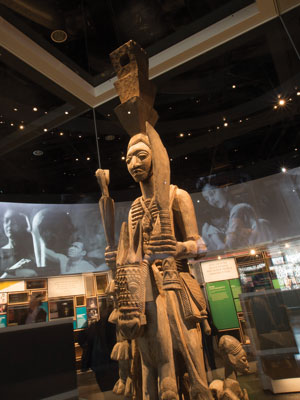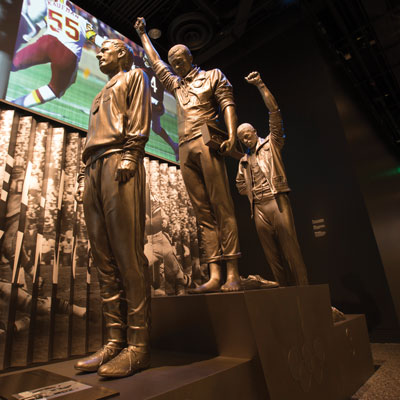The Smithsonian National Museum of African American History and Culture opened on the National Mall in September. Museum Specialist Mary Elliott helped research, conceptualize and design the museum’s “Slavery and Freedom” exhibition. She contributed to the exhibition script, consulted with expert scholars, and identified and secured collection donations featured in the museum. Tickets to the museum are hard to come by, having sold out months in advance. In February, Elliott visited Peoria for the Caterpillar Visitors Center’s Black History Month Celebration and provided an inside look at the museum, its intended story and its impact on visitors.
The museum has a very exquisite design. What is the meaning behind it?
When you look at photos of the museum, you see a three-tiered building, but in fact, it goes several stories down below ground. It starts with the History Gallery, which is below ground and shares stories from 15th-century Africa and Europe to the present. Next is the Community Gallery, which includes the stories of sports, military and the “power of place”—sites important not just to African Americans, but to all Americans. It also contains “making a way out of no way,” the pillars of things we used to move the community forward: the church, education, press, entrepreneurship, science and technology. Finally, the top section of the building is the Culture Gallery. This includes cultural expressions, visual arts, musical crossroads and taking the stage.
 The building is wrapped with a bronze-aluminum treatment. It has a filigree design which was inspired by the ironworks of African-American blacksmiths who worked in the Carolinas and Louisiana. The building gives you the sense of rising up. It is based off of a corona that is at the top of a sculpture which would have stood outside a building on the Western African coast.
The building is wrapped with a bronze-aluminum treatment. It has a filigree design which was inspired by the ironworks of African-American blacksmiths who worked in the Carolinas and Louisiana. The building gives you the sense of rising up. It is based off of a corona that is at the top of a sculpture which would have stood outside a building on the Western African coast.
What is your favorite object in the museum?
I’m asked this frequently, and I don’t have a favorite object. I honestly love everything in the museum, and I’m not being cheeky. My favorite thing about the museum is the interaction between the visitors. Our visitors are Black, White, Asian, Latino, young men, young women, older men, older women. There’s intergenerational conversation going on. People are making space for each other to wrestle with this history.
What story does the museum tell?
This is more than the “Black museum”—this is the National Museum of African American History and Culture. It’s the story of America told through the African-American lens: a lens which looked out onto a world that was, and still is, interracial and multi-ethnic, with diverse faiths and diverse genders. We tell all of these stories throughout the museum.
We say the museum is “a people’s journey, a nation’s story.” It’s “a people’s journey” because we humanize it. There is human suffering and the power of the human spirit. Think about the human spirit, about someone experiencing the horrors of a human slave ship and saying, “I have to live.” There’s strength in that. There is the harsh reality of slavery, but there’s also resistance, resilience and survival. I tell everyone who is visiting the museum to look for those moments. Our American history is not simple—but it’s ours. And it’s “a nation’s story” because we did this together, and we’re moving forward together.
Tell us about Caterpillar’s support of your museum, from donating to digging.
We all know there are corporations who donate money and they want to do a check on their list, saying they’ve done their work for diversity. I can tell you for a fact there’s a great deal of sincerity from Caterpillar. This is not just a checkmark on a piece of paper to Caterpillar. Everybody is going to the museum and they’re thinking more deeply about what it is to be American, and that’s pivotal at this time. In order for us to move forward, we have to have a civic education. In this day and age, everyone looks to science, technology and math. But we also must look to the humanities. Caterpillar sees the importance of this.

We are very proud an African-American woman received the contract to dig out all the dirt to make way for the museum. Of course, Cat equipment was used all around the site. It’s one thing to give funding, but it’s another to physically see partnerships like the one we have with Caterpillar. Caterpillar was on the site every day—and it is a big deal.
 When you think of the division in our country, what can we learn from history that we could use today?
When you think of the division in our country, what can we learn from history that we could use today?
Being open-minded and having honest discussions are key. The museum exhibitions open with a quote from John Hope Franklin, a renowned scholar, saying “Tell the unvarnished truth.” The museum is powerful because of the artifacts, visuals and stories within, but it’s even more powerful when you look at the visitors, the cross-section of people who come to the museum. The visitors are all with each other, talking with each other, sharing memories.
One time, I was giving a tour to a group of congressional members. There was one congressional member in particular who had a presence of someone in the military. He had a straight face throughout the tour, until we came to the exhibition on segregation, when he had tears in his eyes. He said, “This museum really makes you understand what it is to be American.” Then, he gave me a bracelet that said “redemption.” He told me, “This says redemption; it doesn’t say perfection.” This is true—we are not perfect. There is a lot we have to do together. We have been through hard times before. It’s important to engage in conversation, regardless if the person has a different opinion. iBi
Learn more about the Smithsonian National Museum of African American History and Culture at nmaahc.si.edu.


